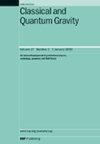On the symmetry of Special Quantum Relativity
IF 3.6
3区 物理与天体物理
Q2 ASTRONOMY & ASTROPHYSICS
引用次数: 0
Abstract
Quantum reference frame as in the example of observing a quantum particle from another has been a topic of much recent interest. Quantum spatial translations, quantum rotations, and quantum Lorentz boosts in the sense have been studied to some extent. The article aims at using a consistent formulation of all that to give a full picture of what would be the symmetry of Special Quantum Relativity as special relativity as seen from quantum particles. We first look at a direct formulation of the mathematical quantum analog of any classical one-parameter Lie group of such transformations suggested by our Heisenberg picture thinking of quantum mechanics. A quantum rotation and a quantum Lorentz boost are presented. Analysis of the compositions of two such transformations shows unnatural results with various problems, especially with their commutators. From a physical point of view, we argue for a modified formulation. A quantum reference frame transformation, as the description of firstly the spacetime position of an object, idealized as a particle, as seen from another has to involve a full set of four-coordinate quantum quantities instead of one in a single coordinate only. Unlike the classical case, we illustrate that the analog of a change by the zero classical coordinate values has nontrivial effects in the transformation. A consistent full picture of the symmetry is then obtained. Results that could be interpreted essentially as the quantum analogs of the translation of a single coordinate observable, including angular ones for a rotation or a boost, can be retrieved from that but only as approximations. Under the traditional perspective of relativity symmetry being about spacetime reference frames, our task is then completed. We further look at the quantum version of Heisenberg–Weyl symmetry and perspectives on its relation with the subject matter and argue for the necessity of our background noncommutative geometric perspective for a conceptual consistent story.论狭义量子相对论的对称性
量子参考系,例如从另一个量子粒子观察一个量子粒子的例子,是最近很感兴趣的一个话题。量子空间平移、量子旋转和量子洛伦兹增强在一定程度上得到了研究。这篇文章的目的是使用一个一致的公式来给出一个完整的画面,从量子粒子的角度来看,什么是特殊量子相对论的对称性。我们首先看一下由海森堡量子力学图像思维提出的任何经典单参数李群变换的数学量子模拟的直接公式。提出了一个量子旋转和一个量子洛伦兹推进。对这两种变换的组合的分析表明,对于各种问题,特别是它们的换向子,结果是不自然的。从物理学的观点来看,我们主张修改公式。一个量子参照系变换,首先是描述一个物体的时空位置,理想化的粒子,从另一个角度来看,必须涉及一组完整的四坐标量子量,而不是一个单一坐标的量子量。与经典情况不同,我们说明了由零经典坐标值变化的类比在变换中具有非平凡的影响。这样就得到了对称的全貌。结果本质上可以解释为单个可观测坐标平移的量子类似物,包括旋转或推进的角度,可以从中检索,但只能作为近似值。在相对论的传统观点下,对称是关于时空参照系的,我们的任务就完成了。我们进一步研究了海森堡-魏尔对称的量子版本及其与主题的关系,并论证了我们的背景非交换几何视角对于概念一致性故事的必要性。
本文章由计算机程序翻译,如有差异,请以英文原文为准。
求助全文
约1分钟内获得全文
求助全文
来源期刊

Classical and Quantum Gravity
物理-天文与天体物理
CiteScore
7.00
自引率
8.60%
发文量
301
审稿时长
2-4 weeks
期刊介绍:
Classical and Quantum Gravity is an established journal for physicists, mathematicians and cosmologists in the fields of gravitation and the theory of spacetime. The journal is now the acknowledged world leader in classical relativity and all areas of quantum gravity.
 求助内容:
求助内容: 应助结果提醒方式:
应助结果提醒方式:


